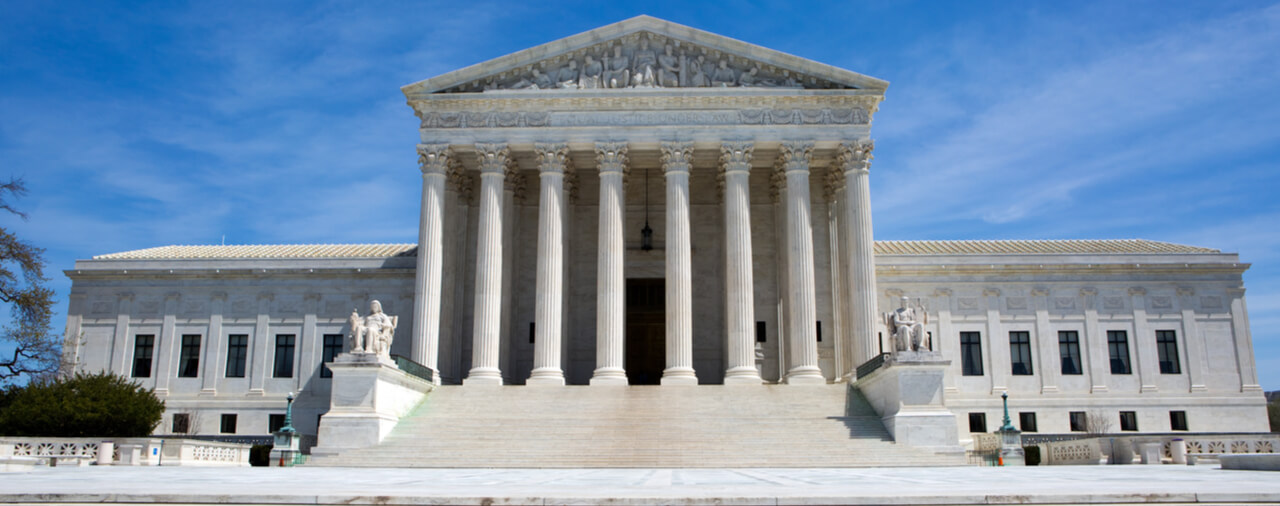Introduction
On January 31, 2017, President Donald Trump nominated Judge Neil M. Gorsuch of the United States Court of Appeals for the Tenth Circuit to the United States Supreme Court [see blog]. Judge Gorsuch was nominated to fill the seat that has been vacant since the death of former Justice Antonin Scalia on February 13, 2016 [see blog on Justice Scala’s career]. In this article, I will offer an overview of Judge Gorsuch’s career and known positions, with an emphasis on issues that relate to the administration of the immigration laws. In conclusion, I will explain why Judge Gorsuch is an exceptional pick for the vacant Supreme Court seat and why the Senate should move expeditiously to confirm him.
Background
Judge Gorsuch recently submitted his responses to a questionnaire issued by the Senate Judiciary Committee [PDF version]. This committee will vote whether to refer the nomination to the full Senate following a hearing at which Judge Gorsuch will appear. We will rely on the questionnaire and other sources to examine Judge Gorsuch’s background in brief.
Judge Gorsuch was born on August 29, 1967. At 49 years of age, he is the youngest individual nominated to the Supreme Court since now-Justice Clarence Thomas was nominated at 43 years of age in 1991.
Judge Gorsuch obtained his undergraduate degree from Columbia University in 1988. He procured his law degree from Harvard Law School in 1991. If confirmed, Judge Gorsuch will be the sixth Justice on the Court to have graduated from Harvard Law School. Judge Gorsuch subsequently studied at Oxford University, receiving a Doctor of Philosophy in Law degree in 2004.
After completing Harvard Law School, Judge Gorsuch clerked for Judge David B. Sentelle of the United States Court of Appeals for the D.C. Circuit from 1991-1992. Judge Gorsuch then clerked for Justice Byron White and Justice Anthony Kennedy of the United States Supreme Court from 1993-1994. If confirmed, Gorsuch will be the only Justice to have clerked for one of his colleagues (Justice Kennedy).
Subsequent to his clerkships, Judge Gorsuch worked in private practice from 1998-2005. From 2005-2006, he worked in the United States Department of Justice (DOJ) as a Principal Deputy Associate Attorney General. In 2006, President George W. Bush nominated Gorsuch to replace Judge David M. Ebel on the United States Court of Appeals for the Tenth Circuit. Gorsuch was confirmed by the United States Senate by voice vote with no registered opposition.1 Judge Gorsuch has served on the Tenth Circuit since he was confirmed in 2006.
In an interesting side-note, Judge Gorsuch’s mother — Anne Gorsuch Buford — served as the Administrator of the Environmental Protection Agency for two years under President Ronald Reagan.
Interesting Writings
Before examining Judge Gorsuch’s record on the bench, it is work noting two pieces of writing that he completed prior to being confirmed to serve on the Tenth Circuit.
The subject of Judge Gorsuch’s research at Oxford University was assisted suicide. After completing his dissertation, Judge Gorsuch published a book titled The Future of Assisted Suicide and Euthanasia (Princeton University Press 2006). In the book, he examined assisted suicide in great detail and assessed the moral and legal arguments for and against it. The issues touched on in this book are outside the scope of what I will focus on in this post, but it is a noteworthy book that is likely to come up in Judge Gorsuch’s confirmation hearings. In the book, he argued against assisted suicide, concluding, “All human beings are intrinsically valuable, and the intentional taking of human life by living persons is wrong.”2
In an article more relevant to the scope of what we will be examining, Gorsuch penned an article for the conservative National Review in 2005 — prior to taking the bench — titled Liberals’N’Lawsuits.3 In the article, Gorsuch opined that “American liberals have become addicted to the courtroom, relying on judges and lawyers rather than on elected leaders and the ballot box, as the primary means of effecting their social agenda…” Gorsuch contrasted this with relying on the judiciary only in “extraordinary” cases. He argued that such reliance by the left on the judiciary to advance policy objectives “is bad for the country and bad for the judiciary.” Part of the problem, he noted, was that once judges rule that a policy is unconstitutional, one side wins and the other side loses, which robs society “of the give-and-take of the political process and the flexibility of social experimentation that only the elected branches can provide.” Furthermore, Gorsuch noted that in his opinion relying on the judiciary to advance policy objectives leads to the politicization of the judiciary. In conclusion, he observed that, during the New Deal, liberals recognized that the “elected branches are generally the appropriate engines of social reform,” and he praised Democratic-appointed judges of that era for arguing for “judicial restraint and deference to the right of Congress to experiment with economic and social policy.”
In an op-ed published recently in the New York Daily News, noted lawyer and legal scholar Ilya Somin expressed concerns with Gorsuch’s National Review article.4 Somin praised many aspects of Judge Gorsuch’s record on the bench. However, referring to the opinions voiced in the article, Somin criticized Gorsuch’s praise for the Democratic-appointed judges who, during the New Deal period, employed “judicial restraint and deference to the right of Congress to experiment with economic and social policy.” As Somin notes, “Liberal jurists of that period advocated near-total abdication of judicial enforcement of limits on federal power.” Somin acknowledged that it is possible that Judge Gorsuch “did not intend to embrace the full implications” of his statements (including those advocating relying on courts only in “extraordinary” circumstances). However, Somin argued that, in light of threats that Somin sees with President Trump’s positions on a variety of issues, Judge Gorsuch’s stated position should be taken “both seriously and literally,” even granting his strong record on the Tenth Circuit.
I share some of Somin’s concerns with Judge Gorsuch’s article in the National Review, and I believe it is a worthy topic for the confirmation hearings. However, it is important to note that the article was written to concur with an argument that liberals should look for policy solutions to policy debates rather than to the judiciary, thus suggesting that the matters addressed — in Gorsuch’s opinion — presented pure policy questions rather than legal issues appropriate for judicial review. However, he did indeed go beyond that in seeming to advocate excessive judicial deference to the political branches. Fortunately, as we shall examine, Judge Gorsuch’s record on the bench and his general approach to the law suggest that he is more willing than he suggested in that article to exercise judicial review where it is warranted.
Judge Gorsuch’s Legal Philosophy
Judge Gorsuch has often been compared to Justice Antonin Scalia in his legal philosophy. He is known as being a textualist, meaning that he seeks to analyze statutes by analyzing the plain meaning of the text, to the exclusion of things such as legislative history and intent. We will see these principles at play in a small selection of Judge Gorsuch’s written decisions.
Judge Gorsuch wrote a law article upon the death of Justice Scalia [PDF version], in which the stated that Justice Scalia had reminded judges “[t]hat judges should … strive … to apply the law as it is, focusing backward, not forward, and looking to the text, structure, and history to decide what a reasonable reader at the time of the events in question would have understood the law to be-not to decide cases based on their own moral convictions or the policy consequences that they believe might serve society best.”5 Judge Gorsuch disagreed with criticisms of Justice Scalia’s legal philosophy to the effect that he had focused too much on process and not enough on results. Judge Gorsuch described himself as “an adherent to the view that outcomes (ends) do not justify methods (means).6 Judge Gorsuch further described judicial power as “[n]ot a forward-looking but backward-looking authority.” By this, he explained, he meant that judicial power was not for “making new rules of general applicability, but a means for resolving disputes about what existing law is and how it applies to discrete cases and controversies.”7
Although it is never a given how an individual will rule once he or she is on the Supreme Court, Judge Gorsuch’s principles of legal interpretation bear strong similarities to those of Justice Scalia, although they may differ on several key issues that we will examine. On the current court, Judge Gorsuch’s textualist approach bears similarities on the surface to the approach of Justice Clarence Thomas.
Judge Gorsuch on Three Areas Relating to Immigration
Federal judges handle cases from all areas of law, and the vast majority of issues do not implicate the immigration laws. The three areas through which federal judges have the most significant effect on immigration law by their rulings are criminal appeals, immigration appeals, and administrative law decisions. In the following sections, we will examine a few of Judge Gorsuch’s opinions in these areas and look for clues as to how he may rule on the Supreme Court.
However, it is important to note that, as a circuit court judge, Judge Gorsuch has been bound by Supreme Court precedent. That means if the Supreme Court has previously spoken to a legal issue that is before the Tenth Circuit, the Tenth Circuit is required to follow the Supreme Court precedent. Conversely, the Supreme Court may reconsider any prior precedent and revise or overrule it. Thus, as a justice of the Supreme Court, Gorsuch would have significantly more latitude.
The question faced by a Supreme Court Justice in general and in any given case is ultimately the degree of his or her acceptance of stare decisis, that is, determining cases in accord with precedent. It is hard to say at this time how Judge Gorsuch would balance the interest in stare decisis in deciding a case when he believes a prior decision — or line of decisions — was wrong. This is one area where the views of two of the Supreme Court’s most well-known textualists — Justices Scalia and Thomas — differed. With regard to stare decisis. Justice Scalia was generally more deferential to the principle of stare decisis than Justice Thomas.
Criminal Law
Eric Citron of Scotusblog described Judge Gorsuch as believing that “criminal laws should be clear and interpreted in favor of defendants even if it hurts government prosecutions (like Scalia).”8 In the immigration context, Supreme Court precedent on how to interpret and apply criminal statutes has a significant effect on aliens with criminal convictions. Please see our articles on Descamps v. United States, 133 S. Ct. 2276 (2013) [see article] and Mathis v. United States, 579 U.S. __ [see article] for two examples of cases where the Supreme Court created precedent for reading federal sentencing enhancement statutes and criminal statutes in a manner that was generally favorable to aliens with criminal convictions.
One of Judge Gorsuch’s most notable pieces of writing from the bench came in United States v. Games-Perez, 667 F.3d 1136 (10th Cir. 2012) [PDF version].
The question regarded the requirements for a conviction under 18 U.S.C. 922(g)(1) and 924(a)(2). 18 U.S.C. 922(g)(1) makes it unlawful for an individual “who has been convicted in any court of a crime punishable by imprisonment for a term exceeding one year” to “ship or transport in interstate or foreign commerce, or possess in or affecting commerce, any firearm or ammunition; or to receive any firearm or ammunition which has been shipped or transported in interstate or foreign commerce.” 18 U.S.C. 924(a)(2) states that “[w]hoever knowingly violates subsection … (g) … of section 922 shall be fined as provided in this title, imprisoned not more than 10 years, or both.”
A three-judge panel of the Tenth Circuit (which included Judge Gorsuch), had found that the government was not required to establish that an individual knew that he or she had been convicted of a crime punishable by imprisonment for a term exceeding one year in order to secure a conviction under the relevant provisions. Judge Gorsuch concurred in the judgment because he felt bound by precedent, but he expressed his issues with the Tenth Circuit precedent and urged reconsideration.
The appellant made an en banc request asking for a hearing from the entire Tenth Circuit. The Tenth Circuit denied rehearing en banc 6-4. Judge Gorsuch wrote the opinion for the 4 judges who dissented from denial of rehearing en banc. Interestingly, Judge Gorsuch had been on the 3-judge panel that decided the case initially, and concurred in judgment because he felt bound by precedent, but expressed his issues with the Tenth Circuit precedent (and urged reconsideration) in his concurring opinion.
In his dissent from denial of rehearing en banc, Judge Gorsuch argued that 18 U.S.C. 924(a)(2) requires a showing of “knowingly violat[ing] [18 U.S.C.] 922(g), a statute that in turn prohibits (1) a convicted felon (2) from possessing a firearm (3) in interstate commerce.” He took issue with the Tenth Circuit’s finding that the government was only required to establish that the appellant had knowingly possessed a firearm and not that he had known that he was a convicted felon as defined in 18 U.S.C. 922(g). Wryly, Judge Gorsuch stated that the Tenth Circuit precedent the Court had relied on interpreted “Congress’s mens rea requirement as leapfrogging over the first statutorily specified element and touching down at the second listed element — def[ying] grammatical gravity and linguistic logic.” Judge Gorsuch cited to the Supreme Court decision in Flores-Figueroa v. United States, 556, U.S. 646, 650 (2009) [PDF version], stating that “when a criminal statute introduces the elements of a crime with the word ‘knowingly,’ that mens rea requirement must be applied ‘to all the subsequently listed [substantive] elements of the crime’” (emphasis and alliteration added by Judge Gorsuch). Judge Gorsuch also criticized both the Government’s and the Tenth Circuit’s reliance on legislative history, stating that “[t]he problem with all this is that hidden intentions never trump expressed ones.”
Judge Gorsuch’s concurrence is highly interesting and worth reading in full. It provides a window into how he reads criminal statutes, and it offers evidence that he may often do so in a way that favors criminal defendants.
In a side-note, we recently posted an article about Voisine v. United States, 579 U.S. (2016) [see article], which addressed the related section 922(g)(9) (statute that prohibits firearm ownership for a crime of domestic violence).
Judge Gorsuch on Immigration and Administrative Law
In 2015 — well before we knew that Judge Gorsuch would be nominated to the Supreme Court — we wrote a comprehensive article on a decision penned by Judge Gorsuch, De Niz Robles v. Lynch, 803 F.3d 1165 (10th Cir. 2015) [see article]. On January 23, 2017, I posted a follow-up blog on Judge Gorsuch’s decision on a similar issue in Gutierrez-Brizuela v. Lynch, 834 F.3d 1142 (10th Cir. 2016) [see blog].
We have already covered both of these decisions in great detail on this site, and I encourage you read our full articles for detailed analysis. In this section, I will address the decisions in brief while providing commentary on a passage Judge Gorsuch wrote about De Niz Robles in the law article he wrote after the death of Justice Scalia.
Both cases addressed whether the Board of Immigration Appeals (BIA) could apply its precedent decision in the Matter of Briones, 24 I&N Dec. 355 (BIA 2007) [PDF version], retroactively to a case in which the Tenth Circuit had reached a different conclusion prior to the BIA decision.
A key issue in both of these cases is that of Chevron deference. Under the Supreme Court decision in Chevron U.S.A., Inc. v. Natural Resources Defense Council, Inc., 467 U.S. 847 (1984) [PDF version], courts are generally required to defer to an administrative agency’s reading of a statute where the statute is ambiguous and the agency’s reading of the statute is reasonable. The Supreme Court decision in National Cable & Telecommunications Association v. Brand X Internet Services, 545 U.S. 967 (2005) [PDF version] extended deference to administrative agencies in the face of contrary judicial precedent, provided that the statute in question is ambiguous.
In both cases, Judge Gorsuch followed Chevron and Brand X in deferring to the Board’s decision in the Matter of Briones, but he found that neither allowed the Board to apply Briones retroactively when there was contrary Tenth Circuit precedent. In his concurring opinion in Gutierrez-Brizuela, Judge Gorsuch expressed his qualms with both Chevron and Brand X — and the threat he saw in their vesting too much power in the Executive branch — in great detail. Both decisions are worth reading in full — along with our articles — as they are instructive about administrative law issues and provide a window into Judge Gorsuch’s thinking on one of the most important issues that will come before the Supreme Court.
In Judge Gorsuch’s article written upon the death of Justice Scalia, he described the De Niz Robles case as follows: “an executive agency acting a faux-judicial proceeding and exercising delegated legislative authority purported to overrule an existing judicial declaration about the meaning of existing law and apply its new legislative rule retroactively to already completed conduct. Just describing what happened here might be enough to make James Madison’s head spin.”9 Judge Gorsuch laid out the issues that he believed were at stake: “combining what are by design supposed to be separate and distinct legislative and judicial powers poses a grave threat to our values of personal liberty, fair notice, and equal protection.”
On the issue of administrative law, Judge Gorsuch’s views may be distinguishable from not only those of Justice Scalia but also from those of the other Justices sitting on the court currently (note that Justice Thomas was the author of Brand X). However, despite Justice Scalia’s acceptance of Chevron, he did read it more narrowly than did most of his colleagues, leading Citron to suggest that “given [Gorsuch’s and Scalia’s] parallel commitments to textualism and their parallel understandings of the relative roles of agencies and courts, even this seems like a bridgeable divide between Gorsuch and the justice he might replace.”
Judge Gorsuch offered an interesting opinion dissenting from rehearing en banc in United States v. Nichols, 784 F.3d 666 (10th Cir. 2015) [PDF version], addressing the non-delegation doctrine in the criminal law context from the standpoint of its potential danger to the separation of powers and individual liberty.10
Please see our article about Judge Gorsuch’s opinion in Montano-Vega v. Holder, 721 F.3d 1175 (10th Cir. 2015) [PDF version], to read about another interesting precedent decision by Judge Gorsuch on immigration law [see article].
Conclusion
With the nomination of Judge Gorsuch, President Trump fulfilled his campaign promise to choose a worthy replacement to Justice Scalia for the Supreme Court. Judge Gorsuch has impeccable credentials, and his textualist approach to reading law will be a valuable addition to the Court that arguably only has one Justice — Justice Thomas — who is a full-spectrum textualist and originalist. As Josh Blackman wrote, “[a]s a committed originalist, sound jurist and brilliant writer, Gorsuch will serve as a worthy intellectual heir to Justice Scalia.”11
In the immigration context, Judge Gorsuch’s record suggests that he may read the law in a way that would be favorable to aliens in the criminal law context. Judge Gorsuch’s views on administrative law and judicial deference have the potential to be his most significant contribution to the bench, if they gain traction with his colleagues. I encourage the Senate to confirm Judge Gorsuch expeditiously, and I look forward to seeing him on the Supreme Court.
- Mulkern, Anne C., “Gorsuch confirmed for 10th Circuit,” denverpost.com, (Jul. 20, 2006)
- Hawkins, Derek, “Neil Gorsuch wrote the book on assisted suicide. Here’s what he said.” washingtonpost.com, (Feb. 1, 2017)
- Gorsuch, Neil, “Liberals’N’Lawsuits,” nationalreview.com, (Feb. 7, 2005)
- Somin, Ilya, “Supreme Court pick Neil Gorsuch has troubling views on federalism and judicial review,” nydailynews.com, (Jan. 31, 2017)
- Honorable Neil M. Gorsuch, 2016 Sumner Canary Memorial Lecture: Of Lions and Bears, Judges and Legislators, and the Legacy of Justice Scalia, 66 Case W. Res. L. Rev. 905 (2016), 906
- Id. 906
- Id. 910
- Citron, Eric, “Potential nominee profile: Neil Gorsuch,” scotusblog.com, (Jan. 13, 2017)
- Gorsuch, Memorial Lecture, 915
- Feder, David, “The Administrative Law Originalism of Neil Gorsuch,” yalerjreg.com, (Nov. 21, 2016)
- Blackman, Josh, “My Take in Politico on Judge Gorsuch: ‘The Kennedy Whisperer,;” joshblackman.com, (Feb. 1, 2017)





